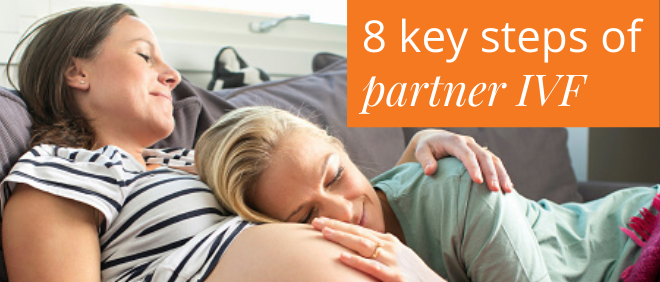Proudly part of the City Fertility Network
Proudly part of the City Fertility Network

By Dr Natasha Andreadis, Fertility Specialist at Rainbow Fertility Sydney CBD.
Partner IVF is a type of IVF that allows both partners to become physically involved in the conception of their baby. It involves one partner providing the eggs which are fertilised with donor sperm, and the other partner carrying the pregnancy.
It is a very appealing concept for many couples, and sometimes couples may even swap the roles for their second child. The appeal of swapping roles for the second child is that each partner gets to experience both childbearing and having a biological connection to a child.
The process of Partner IVF is almost identical to the standard IVF process.
At your first consultation, your specialist will take a thorough medical history from you and your partner and perform any relevant examinations. Many tests will be ordered. The specialist will use this information to provide you with the best options to maximise your chance of conceiving a baby.
As part of fertility services involving the use of donors, anyone who is going to donate eggs, sperm or embryos or anyone who is going to become a recipient of sperm, eggs or embryos is required to have counselling.
All parties receive compulsory counselling to consider the legislative/regulatory requirements and the long-term implications of becoming a donor or donor recipient. Complex emotional and social issues are discussed as well as psychological implications and plans for future exchange of information and contact.
Choose a sperm donor, either a known donor or a clinic-recruited donor (unknown donor). Couples who are considering Partner IVF will have to decide which type of sperm donor is right for them. For help in choosing the right option for you, visit our Donor Program page or talk to your fertility specialist. The Addam App is a good place to start if looking for clinic recruited sperm.
Once a sperm donor is chosen, they are required to go through a routine medical assessment, detailed screening and legal documentation. Consent forms and counselling then needs to be completed before the medical procedure can start.
Your fertility specialist will review all results and advise on the treatment plan. Partners may synchronise their menstrual cycles and have treatment in parallel (while one will have their ovaries stimulated the other will have their uterine lining prepared for embryo transfer).
Another common scenario is the eggs are collected, inseminated with donor sperm and embryos created and frozen. The embryos are then later inserted into the uterus of the person who intends to carry the baby.
The partner who is providing the eggs takes medication to stimulate their ovaries and promote the growth of follicles, which contain the eggs. While the ovarian stimulation process takes place, the partner who will carry the pregnancy may take medication to support the development of the endometrium (lining of the uterus) in preparation for embryo transfer.
Once the ovarian stimulation phase ends, eggs will be retrieved from one partner and fertilised with the donor sperm to create embryos.
A selected embryo is then transferred to the partner who will carry the pregnancy.
14 days following the embryo transfer, a blood test is carried out on the carrying partner to determine if pregnancy is successful.
It is important that if you are considering undergoing this type of treatment, you take the time to decide which partner will contribute the egg and which partner will carry the pregnancy. Carefully considering the pros and cons of each role and talking openly with each other about your expectations for the pregnancy is recommended.
Rainbow Fertility is Australia’s first dedicated LGBTQ+ fertility and IVF service provider in Australia. We offer dedicated advice on family options for the LGBTQ+ community and have modern centres, state-of-the-art laboratories, highly qualified and experienced doctors, and compassionate and caring staff.
For more information or to book an appointment contact our friendly team. Phone: 1300 222 623 or email: info@rainbowfertility.com.au